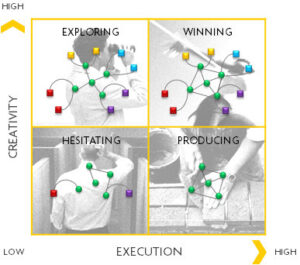I read a post from my friend Chris Ernst a while back titled, “What Thomas Edison Knew About Innovation Networks.” While revising the article recently it reminded me of work we’ve done helping companies increase innovation by mapping and analyzing their informal networks. As organizations create matrix structures, form virtual teams, forge alliances, and outsource functions, they increasingly put their faith in networks of relationships to get things done.
These relationship networks (i.e. who works with who, who gravitates to who, who interacts with who, etc.) are critical to successful innovation. This makes intuitive sense when you think about it. Innovation is fundamentally about connections. It’s about bringing together pieces of disparate information to spark a new insight. According to Dr. Mike Addison, Section Head for Corporate R&D at Procter and Gamble, “Innovation is all about making new connections. Most breakthrough innovation is about combining knowledge in new ways or bringing an idea from one domain to another.” Or, as described by legendary innovator Steve Jobs, “Creativity is just connecting things.”
Using organizational network analysis (ONA), you can chart a company’s informal network–the ways in which people work together to solve problems and make decisions–to understand how innovation really happens. What we’ve found is that a company’s innovation network typically falls into one of four types: Exploring, Producing, Hesitating, and Winning (see figure 1).
Figure 1: Types of Innovation Networks

Companies with a loosely coupled network in which connections cross functional silos and geographic boundaries have an Exploring innovation network (Quadrant 1 in Figure 1). This type of innovation network generates great ideas because members have access to all sorts of new and different information as a basis for creativity. At the same time, these same networks struggle to commercialize their ideas because network members don’t have the cohesiveness network needed to effectively execute. In contrast, companies with a tightly-knit, centralized group of innovators with few external relationships have a Producing innovation network (Quadrant 3). Their ‘group think’ makes them very good at execution but the lack of outside connections means members struggle to think outside the box. As a result, these networks typically produce lots of me too products.
Any company focused on real innovation wants to be in Quadrant 2. Quadrant 2 depicts a Winning innovation network. This innovation network incorporates the best of both worlds: external connections that provide access to the new and novel information needed for creativity as well as a close-knit core group that can effectively commercialize ideas. The result is a steady stream of innovation products and services that impacts the top and bottom line.
By analyzing their organizational network, companies can understand which type of innovation network they have and determine what they might need to do to restructure it. Thus, when building innovation capabilities the old adage is true, “It’s not what you know, but who you know that matters.”
